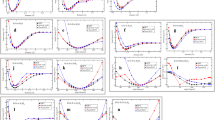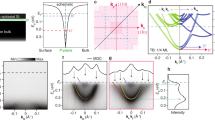Abstract
The requirement for increasingly thin (<50 Å) insulating oxide layers in silicon-based electronic devices highlights the importance of characterizing the Si–SiO2 interface structure at the atomic scale. Such a characterization relies to a large extent on an understanding of the atomic-scale mechanisms that govern the oxidation process. The widely used Deal–Grove model invokes a two-step process in which oxygen first diffuses through the amorphous oxide network before attacking the silicon substrate, resulting in the formation of new oxide at the buried interface1. But it remains unclear how such a process can yield the observed near-perfect interface2,3,4,5,6,7,8,9,10,11,12. Here we use first-principles molecular dynamics13,14,15 to generate a model interface structure by simulating the oxidation of three silicon layers. The resulting structure reveals an unexpected excess of silicon atoms at the interface, yet shows no bonding defects. Changes in the bonding network near the interface occur during the simulation via transient exchange events wherein oxygen atoms are momentarily bonded to three silicon atoms — this mechanism enables the interface to evolve without leaving dangling bonds.
This is a preview of subscription content, access via your institution
Access options
Subscribe to this journal
Receive 51 print issues and online access
$199.00 per year
only $3.90 per issue
Buy this article
- Purchase on Springer Link
- Instant access to full article PDF
Prices may be subject to local taxes which are calculated during checkout


Similar content being viewed by others
References
Deal, B. E. & Grove, A. S. General relationship for the thermal oxidation of silicon. J. Appl. Phys. 36, 3770–3778 (1965).
Rochet, F.et al. The thermal oxidation of silicon: The special case of the growth of very thin films. Adv. Phys. 35, 237–274 (1986).
Stoneham, A. M., Grovenor, C. R. M. & Cerezo, A. Oxidation and the structure of the silicon/oxide interface. Phil. Mag. B 55, 201–210 (1987).
Mott, N. F., Rigo, S., Rochet, F. & Stoneham, A. M. Oxidation of silicon. Phil. Mag. B 60, 189–212 (1989).
Gusev, E. P., Lu, H. C., Gustafsson, T. & Garfunkel, E. Growth mechanism of the thin silicon oxide films on Si(100) studied by medium-energy ion scattering. Phys. Rev. B 52, 1759–1775 (1995).
Gusev, E. P., Lu, H. C., Gustafsson, T. & Garfunkel, E. in The Physics and Chemistry of SiO2and the Si-SiO2Interface — 3Vol. 96-1 (eds Massoud, H. Z., Poindexter, E. H. & Helms, C. R.) 49–58 (Electrochemical Soc., Pennington, (1996)).
Fahey, P., Griffin, P. B. & Plummer, J. D. Point defects and dopant diffusion in silicon. Rev. Mod. Phys. 61, 289–384 (1989).
Banaszak Holl, M. M. & McFeely, F. R. Si/SiO2Interface: New structures and well-defined model systems. Phys. Rev. Lett. 71, 2441–2444 (1993).
Banaszak Holl, M. M., Lee, S. & McFeely, F. R. Core-level photoemission and the structure of the Si/SiO2interface: A reappraisal. Appl. Phys. Lett. 85, 1097–1099 (1994).
Pasquarello, A., Hybertsen, M. S. & Car, R. Si 2p core-level shifts at the Si(001)-SiO2interface: A first-principles study. Phys. Rev. Lett. 74, 1024–1027 (1995).
Pasquarello, A., Hybertsen, M. S. & Car, R. Theory of Si 2p core-level shifts at the Si(001)-SiO2interface. Phys. Rev. B 53, 10942–10950 (1996).
Pasquarello, A., Hybertsen, M. S. & Car, R. Structurally relaxed models of the Si(001)-SiO2interface. Appl. Phys. Lett. 68, 625–627 (1996).
Car, R. & Parrinello, M. Unified approach for molecular dynamics and density-functional theory. Phys. Rev. Lett. 55, 2471–2474 (1985).
Pasquarello, A., Laasonen, K., Car, R., Lee, C. & Vanderbilt, D. Ab initio molecular dynamics for d -electron systems: Liquid copper at 1500 K. Phys. Rev. Lett. 69, 1982–1985 (1992).
Laasonen, K., Pasquarello, A., Car, R., Lee, C. & Vanderbilt, D. Car-Parrinello molecular dynamics with Vanderbilt ultrasoft pseudopotentials. Phys. Rev. B 47, 10142–10153 (1993).
Witczak, S. C., Suehle, J. S. & Gaitan, M. An experimental comparison of measurement techniques to extract Si-SiO2interface trap density. Solid-State Electron. 35, 345–355 (1992).
EerNisse, E. P. Stress in thermal SiO2during growth. Appl. Phys. Lett. 35, 8–10 (1979).
Himpsel, F. J., McFeely, F. R., Taleb-Ibrahimi, A., Yarmoff, J. A. & Hollinger, G. Microscopic structure of the SiO2/Si interface. Phys. Rev. B 38, 6084–6096 (1988).
Lu, Z. H., Graham, M. J., Jiang, D. T. & Tan, K. H. SiO2/Si(100) interface studied by Al Kα x-ray and synchrotron radiation photoelectron spectroscopy. Appl. Phys. Lett. 63, 2941–2943 (1993).
Oshishi, K. & Hattori, T. Periodic changes in SiO2/Si(111) interface structures with progress of thermal oxidation. Jpn J. Appl. Phys. 33, L675–L678 (1994).
Sarnthein, J., Pasquarello, A. & Car, R. Structural and electronic properties of liquid and amorphous SiO2: An ab initio molecular dynamics study. Phys. Rev. Lett. 74, 4682–4685 (1995).
Sarnthein, J., Pasquarello, A. & Car, R. Model of vitreous SiO2generated by an ab initio molecular dynamics quench from the melt. Phys. Rev. B 52, 12690–12695 (1995).
Nosé, S. Amolecular dynamics method for simulations in the canonical ensemble. Mol. Phys. 52, 255–268 (1984).
Hoover, W. G. Canonical dynamics: Equilibrium phase-space distributions. Phys. Rev. A 31, 1695–1697 (1985).
Feldman, L. C., Silverman, P. J., Williams, J. S., Jackman, T. E. & Stensgaard, I. Use of thin Si crystals in backscattering-channeling studies of the Si-SiO2interface. Phys. Rev. Lett. 41, 1396–1399 (1978).
Jackman, T. E., MacDonald, J. R., Feldman, L. C., Silverman, P. J. & Stensgaard, I. (100) and (110)Si-SiO2interface studies by MeV ion backscattering. Surf. Sci. 100, 35–42 (1980).
Kosowsky, S. D.et al. Evidence of annealing on a high-density Si/SiO2interfacial layer. Appl. Phys. Lett. 70, 3119–3121 (1997).
Filipponi, A., Evangelisti, F., Benfatto, M., Mobilio, S. & Natoli, C. R. Structural investigation of a -Si and a -Si:H using x-ray absorption spectroscopy at the Si K edge. Phys. Rev. B 40, 9636–9643 (1989).
Car, R. & Parrinello, M. Structural, dynamical, and electronic properties of amorphous silicon: An ab initio molecular-dynamics study. Phys. Rev. Lett. 60, 204–207 (1988).
Acknowledgements
We thank A. Mangili for providing visualization support. The calculations were performed on the NEC-SX4 of the Swiss Center for Scientific Computing (CSCS).
Author information
Authors and Affiliations
Corresponding author
Rights and permissions
About this article
Cite this article
Pasquarello, A., Hybertsen, M. & Car, R. Interface structure between silicon and its oxide by first-principles molecular dynamics. Nature 396, 58–60 (1998). https://doi.org/10.1038/23908
Received:
Accepted:
Issue Date:
DOI: https://doi.org/10.1038/23908
This article is cited by
-
Thermal conductivity of glasses: first-principles theory and applications
npj Computational Materials (2023)
-
Oxidation-induced stress in Si nanopillars
Journal of Materials Science (2019)
-
A doping-less junction-formation mechanism between n-silicon and an atomically thin boron layer
Scientific Reports (2017)
-
From atoms to product reliability: toward a generalized multiscale simulation approach
Journal of Computational Electronics (2013)
-
O2 oxidation reaction at the Si(100)-SiO2 interface: A first-principles investigation
Journal of Materials Science (2005)
Comments
By submitting a comment you agree to abide by our Terms and Community Guidelines. If you find something abusive or that does not comply with our terms or guidelines please flag it as inappropriate.



